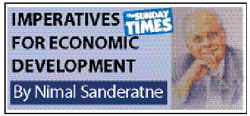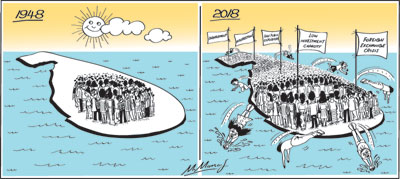Columns
Further reflections on independence: Rapid population growth constrains economic performance
View(s):The two previous columns dealt with the under performance of the economy (January 31st) and the social and economic achievements during the 70 years of independence (February 4th). Today’s column focuses on two of the extenuating factors that impinged on the country’s economic performance: rapid population growth and adverse terms of trade.
 Ethnic violence was the most serious setback to economic development. Among the other constraints were the rapid population growth and the adverse terms of trade (import prices rising relative to export prices), especially the oil price hikes and fall in the prices of the country’s primary exports during several decades.
Ethnic violence was the most serious setback to economic development. Among the other constraints were the rapid population growth and the adverse terms of trade (import prices rising relative to export prices), especially the oil price hikes and fall in the prices of the country’s primary exports during several decades.
Population
One of the main factors that determined the course of economic, political and social development was the very rapid population growth in the first three decades after independence. The curtailment of the death rate in 1946-47, described by the demographer Kingsley Davis, as the “amazing decline in mortality”, led to a sharp increase in population.
The annual average rate of population growth rose to 2.8 per cent in the 1950’s and 2.6 per cent in the 1960s. Even in the 1970’s the population grew by as much as 2.4 per cent. This surge in population led to a doubling of the population 30 years after independence, in 1978. Today’s population of 21 million is thrice the population at independence.
Economic impacts
These demographic developments had significant impacts on the economy and society. The sharp increase in population implied rapid expansion of educational facilities to cope with the increasing school-going population. Even with a constant per capita expenditure on education, the free education system implied a high growth in educational expenditures. Similarly, the country’s food subsidy scheme that continued till 1977, in one form or another, meant that the expenditure on the food subsidy increased continuously.
Strains
This was an enormous strain on the public finances. It increased expenditure on imports and increased the trade deficit resulting in the deterioration of the balance of payments. In turn, the foreign exchange reserves of the country were eroded. The foreign exchange crisis in the 1960s was due to this and the serious deterioration in the terms of trade.
The high social expenditures consequent to this rapid population growth was largely responsible for the government not having a surplus for public investment since the social expenditures were a prior commitment. Capital expenditures in other areas tended to be curtailed with detrimental impacts on economic growth. With larger families household savings too decreased.
Dependency
Population growth also meant a high demographic dependency ratio. In 1971, persons below the age of 20 constituted over half the country’s population and the total demographic dependency ratio was 82 per cent in 1971. Apart from the increase in public expenditure, this implied a low capacity for household savings that in turn affected economic growth adversely.
 Labour force
Labour force
By the 1970s, the high population growth transposed itself into a surge in the labour force. Not only were the numbers seeking employment large, but the country’s successful free education and high school enrolment also meant that those entering the labour force were educated.
Educated unemployed
The economy was not able to absorb these educated youth and a phenomenon of high unemployment among educated youth emerged. Apart from the numbers involved, the suddenness with which this surge of educated unemployed arrived on the scene meant that their expectations, which were geared to employment conditions in the early years after independence, remained unfulfilled. This was a fundamental reason for the country’s insurgency in 1971.
Land scarcity
Population density increased from 103 persons per sq. kilometres at the time of independence to 232 persons in 1980 and 330 today. The rapid increase in population resulted in not only the population density increasing but also the availability of arable land per capita declining sharply. The per capita arable land availability declined to as low as 0.2 hectares by the eighties. This resulted in stresses on both renewable and non-renewable resources such as forests, coral and reef.
Deforestation
The population pressure resulted in increased deforestation owing to an increasing demand for food, firewood and timber. Natural forest cover, which was 84 per cent of land area in 1881, declined to 44 per cent in late 1950s, about 24 per cent in 1991 and; less than 20 percent today. Between 1956 and 1983 it is estimated that the country lost 38,100 hectares of dry zone forest each year. This dramatic statistic is symptomatic of depletion of other natural resources as well.
Adverse terms of trade
The terms of trade, which is the relationship between export and import prices, deteriorated not only in the late 1950s and 1960s, but in the seventies too when there were oil price hikes. The strain was not obvious at first owing to the good prices that agricultural exports of tea and rubber fetched till after the Korean boom in the late fifties. Once the prices of exports declined the fiscal and foreign exchange burden was enormous.
The sharp increase in prices of oil in the 1970s was a severe strain on the country’s trade balance and balance of payments. However there was a compensatory development with the demand for tea exports rising and consequently international tea prices increasing. Furthermore there was a demand for labour from Middle Eastern countries. This contributed handsomely to the country’s balance of payments. In recent years workers’ remittances have off set about 70 percent of the trade deficit and is a significant factor in reducing poverty and increasing incomes.
Summing up
Post-independence economic development was constrained by rapid high population increases and adverse terms of trade during several periods. The high population growth resulted in substantial social expenditures on education, health and food subsidies, which in turn strained the public finances of the country, had a strong impact on the country’s balance of payments, investment capacity and in the final analysis, the country’s economic growth. It created a serious unemployment situation, which generated social tensions and a violent insurgency, which in turn resulted in a drastic increase in defence expenditure.
The surge in population lay at the foundation of many economic, social and political problems. Although the rate of population growth has fallen to only 0.9 percent, the annual increase in population is as much as 190,000 and it’s an ageing population posing new economic and social problems. The developments in population will play a vital role in the future as it has done in the past.


Leave a Reply
Post Comment